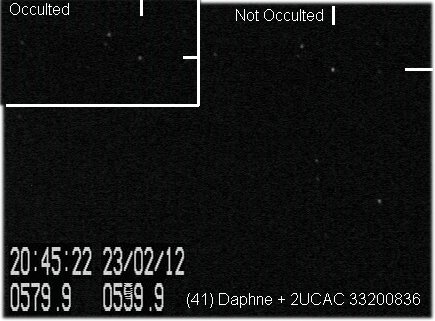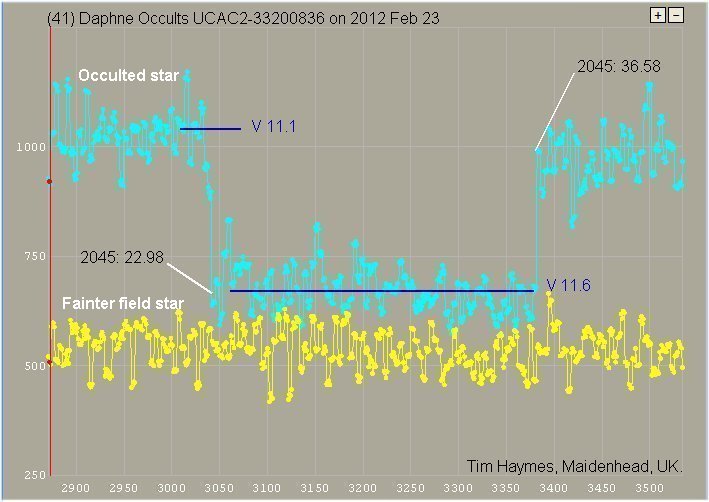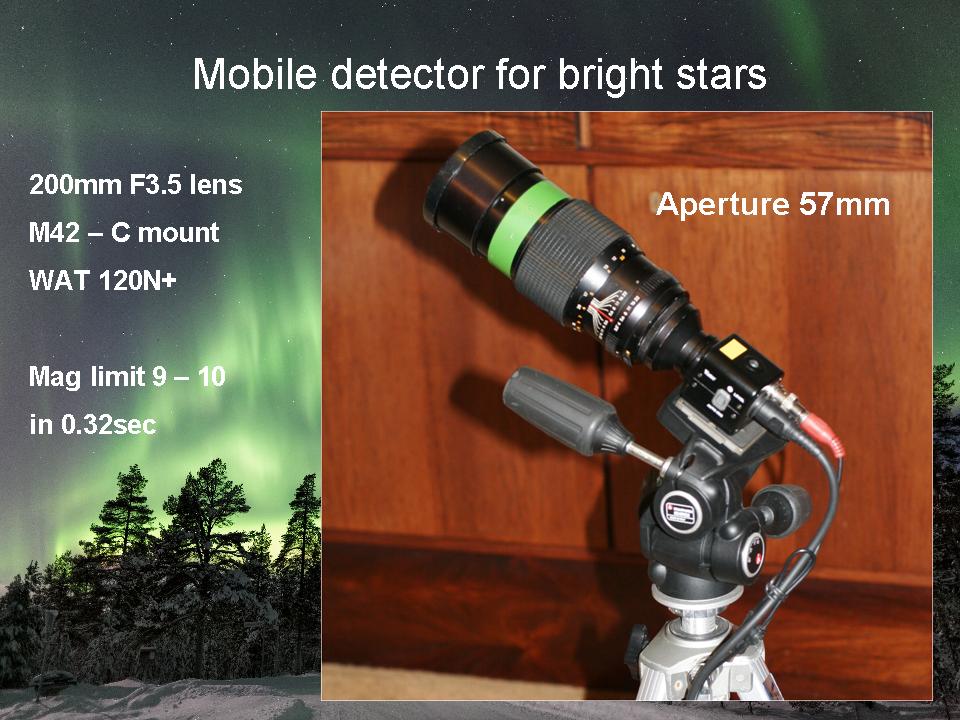A star disappearing
at the Moons limb during a Lunar occultation will
reappear some time later at the oposite limb. But for
an asteroid ( a smaller
object ) the star will reappear within
seconds (1 to 30s) after the asteroid has passed.
OccultWatcher is the planning tool ( for Windows) used by occultation enthusiasts, and is recommended to anyone planning to observe asteroid occultations. Many additional predictions are listed, and these can be customised to local conditions. Occult Watcher Cloud (OWC)is a new resourse for predictions. The information can be filtered more easily. https://cloud.occultwatcher.net/login Timing Accuracy and reliability is improved when recording events by video camera with a GPS video time inserter (VTI). The WATEC 910HX/RC can record at 25fps for Lunar events or set to integrate (stack) frames for asteroid events (0.08 to 5sec) . The VTI overlays the exact UT ( to 1ms ) on each frame of the recording which can then be replayed to get the event time and duration. Here is an example of one frame taken from a video of an asteroid occultation (41-Daphne). The drop brightness between "occulted and not occulted" may look small on the insert, but is very clear when measured in the image on the right. The
video frame above using a GPSBOXSPRITE
time inserter was recorded on: 2012 Feb 23 at 2045hr
22.5799 sec. Times are reported (rounded) to the nearest 10 ms Recording
and analysis. HristoPavlov's
web page (https://www.hristopavlov.net/Observations/Positives/index.html)
is particularly helpful, because the analysis software is used
by most observers. For rare
events and those of high sceintific value, observers do travel. This
is quite common in Europe, and the US. Observations are encouraged to use the equipment they may already have, however the larger the aperture the better for asteroidal occultations. A 10 - 15cm reflector would be a minimum, better still a 20cm F4. SCTs are quite common instruments to use from C6 to C9.25. The C11 possiblty repesents the best in terms weight/appeture. It can be supported by an EQ6 with little problem. Both the EQ and SCT are transportable. The detector and timing arrangement typically would be: a) Analogue 8bit WAT-910/HX with GPSBOXSPRITE3 (Time overlay), video digitiser, and laptop with IOTA Video Capture b)
QHY174 CMOS, or any with IMX174. These are relatively inexpensive (due
to being 1st Generation), with global shutter and big pixels. c) Timing with NTP controlled with Meinberg software, or better, a laptop with GPS via USB. d) A suitable GPS/USB timer is the TIMEBOX-II from Shelyak Instruments
USB
video digitisers: (added Dec 2014) Here is a mobile camera for bright star asteroid occultations down to magnitude 10, consisting of a 200mm F3.5 telephoto lens (Pentax screw thread) adapter (M42 to C-mount) and a Watec 120N+ integrating video camera. Video was recorded on a Sony TRV22E DV camcorder (video/in), or laptop. Predictions with Occult Watcher software Example: (56)Melete
on Jan 17, 2014: The British Astronomical Association Handbook contains predictions a year in advance calculated by E.Goffin. These are used for medium term planning of bright events. OccultWatcher should used for day-to-day for updates nearer the predicted time The BAA web pages are https://britastro.org/asteroids/Occultations.htm Lunar occultation predictions are available in the Lunar Section Circular downloadable from the BAA web site, or predicted using free software. These programs are the result of continuous development by the author/programmer: LOW: Lunar
Occultation WorkBench http://www.softpedia.com/get/Others/Home-Education/Lunar-Occultation-Workbench.shtml
|



